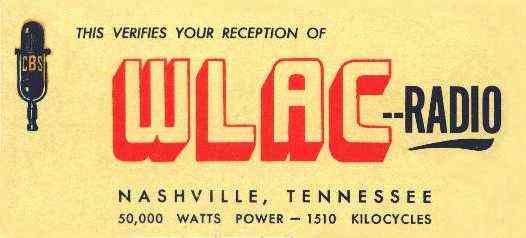
The Unofficial Web Page
|
|
Back in the 1950s, when white teenagers were just beginning to discover that Pat Boone's version of "Ain't That A Shame" was not the original, a radio station in Nashville, Tennessee, was beaming rhythm and blues and gospel music to millions of young listeners, each discretely tuning his dial to 1510 on the AM dial late into the evening hours. It was 10:00 pm in the East, bed time for many a schoolboy. But, if the weather was cooperative and the tuner sensitive enough, wonderful sounds soon began to issue forth. Not Perry Como, not the Chordettes, certainly not Pat Boone. No, here streaming directly into our bedrooms were the strange, new, and wonderful tones of Chuck Berry, Jimmy Reed, Lowell Fulson, Lightning Hopkins, Muddy Waters, Little Junior Parker, The Spaniels, Sonny Boy Williamson, Howling Wolf, and Etta James. Here was something special, something to be shared only with your very best friends, not with those jerks at school who didn't know about it and couldn't understand it if they did. Here was something that made you wish you could soundproof the door to your room or, perhaps, buy a pair of headphones, all to insure that listening bliss might continue into the wee hours when your mother assumed that you had long been asleep. 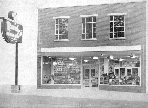
Nothing characterized the WLAC listening experience more than the nightly program sponsored by "The World's Largest Mail Order Phonograph Record Shop" -- Randy's Record Shop in Gallatin, Tennessee. They must have done a heck of a business. No street address, no post office box ... just "Gallatin, Tennessee." During the mid-'50s, Randy's sponsored what may have been the most listened to disc jockey show in the country. Introduced by the nostalgic tones of "Swannee River Boogie" by Albert Ammons, "Randy's Record Hi-Lights" was broadcast on clear-channel WLAC at 10:15 pm Central Time, six nights a week--and at 11:00 pm on Sunday. And 50,000 watts of power insured that it could be heard all over the East, South, and Mid-West, probably in Canada and Mexico as well. 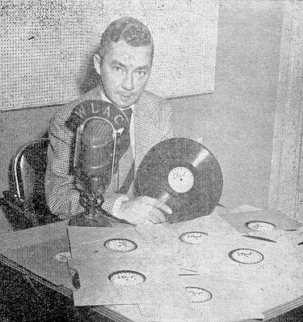
Your genial master of ceremonies was Gene Nobles, seen here holding a soon to be displaced 78 rpm disc. He was ably assisted by engineer George Karsch in the control booth, whom Nobles referred to as "Cohort." Listeners sometimes called him the "ape man," as he occasionally punctuated records and commentary with Johnny Weissmuller's Tarzan ape call, as found on the Dale Hawkins recording of "See You Soon Baboon." I listened to Gene and his show as often as possible. For whatever reason, he was my favorite and I always had the impression that he was the star of the WLAC lineup. I'll never forget, however, the night when my hero's feet of clay were exposed. Nobles' exuberant comments notwithstanding, he didn't always pay attention to the records being played. Evidently, he and the ape man worked from a list prepared in advance of the show. But this night they got out of synch somehow. So just as a record by Chuck Berry had finished playing, poor Gene could be heard saying: "How about that great number by Nervous Norvus, one of my favorites." I've since learned that this slip may have been attributable to the fact that Nobles was known to have consumed a bottle of Seagrams V.O. in the studio each night. Gene Nobles has as much claim as anyone to being the first to play rhythm and blues records for a racially mixed audience and developing a distinctive deejay "patter." Gene called it "Slanguage" and it included such phrases as "from the heart of my bottom." Mr. Nobles passed away in 1989. "Randy" was Randy Wood, a successful entrepreneur whose catalog boasted that his shop was "The Home of the World's Largest Stock of Recorded Music." Randy was patriotic too, offering a "10% discount to all men and women now serving in the Armed Forces." Lest we forget, these records were "also available in 45 r.p.m." Randy Wood was also President of "Dot" Records. Ironically, it was in this capacity, in 1955, that he met with Hugh Cherry of WMAK (Nashville) and was introduced to an aspiring 20-year old singer named Charles Eugene Boone. Wood was impressed and signed the young man to a contract. In November of that same year "Pat" Boone had his first hit on Dot: "Ain't That A Shame." In addition to Boone, Wood's label featured other white artists such as Sanford Clark and, yes, Nervous Norvus. Giving Randy's show a run for its money was the program sponsored by the venerable Ernie's Record Mart, at 179 3rd Avenue North, Nashville, Tennessee. "Ernie's Record Parade" could also be heard every night. It was a one-hour show broadcast Monday through Friday at 9:00 pm Central Time and on Saturday from 8:00 until 9:45 pm. On Sunday night the "all spiritual" show began at 8:30. 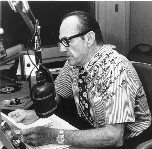
The host on Ernie's show was the steadfast "John R." His full name was John Richbourg and he began working at WLAC in 1942. His distinct, deep, and sometimes gravelly voice, together with his "hep-cat" patter combined to confuse many listeners into believing that he was a black man. Actually, he was a white man who had come to WLAC following stints at other stations and a youthful attempt to pursue a career on the musical stage. John R. signed off for the last time on June 28, 1973. As late as the 1980s, Mr. Richbourg was answering letters from his fans, sending out autographed photos, and selling tapes of his programs. John Richbourg died February 15, 1986 at age 75. At his funeral, gospel singer Ella Washington sang "Amazing Grace" and "Because He Lives." One of his old friends, Motown songwriter Jackie Beavers, performed a song John R. had requested, "Eye on the Sparrow." More details on the life of John R. may be found in an article by Dale R. Patterson at the excellent Rock Radio Retrospective web site. "Ernie" was Ernie Young, details about whom are found in an article about the Radio Four gospel group written in 1995 by Opal Nations. Here is the pertinent portion: Between 1952 and 1955, The Radio Four were captained by the Reverend Dr. Morgan Babb. ... [who] was also taken on as gospel A&R man by Ernie L. Young, founder and president of Nashboro Records out of Nashville in 1951, a post he held for nine years. The kindly, resourceful Young became a part of the Nashville music scene at an early age and was soon supplying records for the juke boxes he operated around the city. When records were taken off the juke boxes, they were sold at his record store, Ernie's Record Mart at 177 Third Avenue. Youthful insomniacs and dedicated listener's could stay up past midnight in the East and listen to the third in the nightly series of record-shop-sponsored shows, this one brought to us courtesy of Buckley's Record Shop. 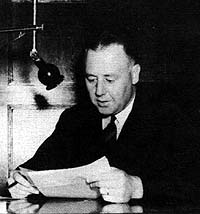
Buckley's show, entitled "After Hours," was introduced by the theme song "After Hours" by Erskine Hawkins. The host disc jockey was a gentleman who seemed to be older than Gene Nobles or John R. That gentleman was Herman Grizzard, pictured here, who had been with the station since the '30s. I would be pleased for someone of you to send me more information regarding Buckley's record shop and the late night show. Each of these record shops offered "special" packages of records available by mail order at a group price. As I recall, each 5-record special from Ernie's was offered for a period of a couple months and was called something like Ernie's "Bullseye" Special or some similar name that would distinguish it from, say, Ernie's "Blue Ribbon" Special. Five records for three dollars or so was a great deal too, as long as you didn't mind having a ringer or two in the group--some title that you probably wouldn't have otherwise purchased. I mean ... did I really want a copy of "Gumbo Mombo" by Guitar Gable? I can remember sitting in bed making notations in a diary detailing the play lists of these shows and the contents of each special record deal. I used to think that the illustrations I drew as borders around these "specials" were quite clever and attractive. Regrettably, that diary has fallen by the way somewhere over the years. Of all the mementos of my youth, it would certainly be in the top 5 that I would wish to retrieve. 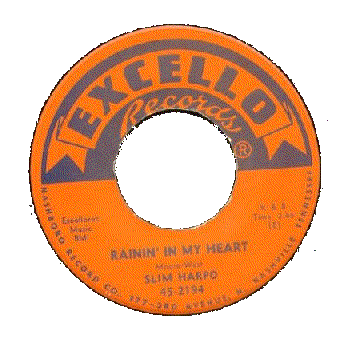
I always thought it was odd that Ernie's seemed to be pushing artists such as Larry Birdsong, Lonesome Sundown, and Lillian Offitt. All became clear when I noticed that the address of Excello Records was 177 3rd Avenue North. It was right next door! That great distinctive Excello sound made me imagine that all of their recordings were being made in the back room at Ernie's. Many years later I learned that I wasn't far wrong, although most of the later Excello artists' sessions were recorded at a studio in Crowley, Louisiana. Yes, Ernie owned the Excello label. So it is no surprise that he chose to pump up sales and promote his artists by including Excello discs in his "special" packages. In truth, this was a relatively benign avenue of promotion by comparison to what was going on elsewhere in the music industry. The best of the Ernie's specials was the "45" Special, described on a special sheet that came in the mail with your records. Here you could select any five records from a list of over 200 "Blues" and "Spiritual" titles for the very agreeable price of $3.05. Gee, looking it over after all these years, I realize that this must be where I got that copy of "Hoo Doo Blues" by Lightnin' Slim. 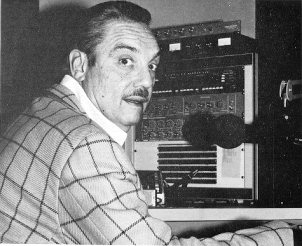
Bill "Hoss" Allen was yet another popular dee-jay at WLAC. After graduating from Vanderbilt in 1948, Allen began his radio career at WHIN in his hometown of Gallatin, Tennessee, hosting "Harlem Hop." Allen soon moved to WLAC, initially filling in where needed, ultimately taking over the 10:15 to midnight spot, when Gene Nobles retired. The "Hossman" also hosted many gospel programs. Indeed, in 1981, Savoy Records released an LP (SL 14627) entitled: Bill "Hoss" Allen Presents "Let's Go To The Program." Subtitled "Twelve of America's Greatest Gospel Groups," the record includes recordings by such groups as The Swan Silvertones, The Soul Stirrers, and The Original Blind Boys of Alabama, introduced by Allen and altered to include applause, as though the performances were actually live, in concert. Allen helped promote the careers of many musicians, but always down played his own significance: I have heard many, many DJs who were a lot more personable, professional, and maybe even knowledgeable. I was just myself. I was just the Hossman. Randy Wood saw it differently: He was completely unique, you might say. He didn't copy anyone, he was an original. A humble man, Allen, enjoyed telling stories at his own expense. One such involved the time in 1950 that Randy Wood offered him the opportunity to become a partner in the upstart "Dot" record label. Allen turned Wood down and by 1956 "Dot" had become so successful that Wood moved his base of operations to Hollywood. Bill Allen died February 25, 1997, at the age of 74. The report of his death by Associated Press, together with a picture of Hoss, Sam Phillips, and others may be found on a separate page. "The 50,000 Watt Quartet"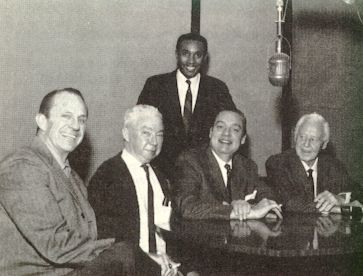
This photograph, probably taken around 1970, shows the legendary WLAC deejays(from left to right) John Richbourg, Gene Nobles, Hoss Allen, and Herman Grizzard. Standing behind them is WLAC news announcer Don Whitehead, the only one of the five who clearly sounded like a white man on the air. To learn far more about the personal lives and exploits of Gene Nobles, Hoss Allen, and all the gang at WLAC in the 1940s and '50s, I highly recommend to you the book "The Pied Pipers of Rock 'n' Roll" by Wes Smith (Longstreet Press, 1989). Subtitled "Radio Deejays of the 50s and 60s," the book contains a chapter devoted to WLAC which recounts many amusing tales of the on and off-air shenanigans of the deejays and their staff. Trust me, this book is a must. Drinking, gambling, "auditioning" female staff members, monitoring an adjacent office building with binoculars, ... I mean, these guys got into more mischief than the Katzenjammer Kids. 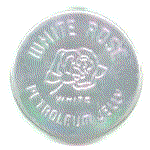
During the hours not sponsored by record shops, WLAC featured a whole slew of wonderful commercials for such things as "live baby chicks," "Royal Crown Hair Dressing" and "White Rose Petroleum Jelly." The disc jockeys used to have a lot of fun mentioning creative uses for that versatile substance, many with double entendre meanings. Indeed, if one could believe the announcer, certain, more active, members of the listening audience were ordering the stuff in the 50-gallon drum size. And, yes, you can still buy it today. 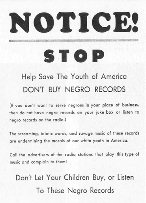
In retrospect, it appears that I got as much meaningful education attending those nightly sessions at 1510 on the dial as I did in many a classroom. My horizons were broadened and I like to think that this process continues. Listening to these magical broadcasts led directly to many another trail, not the least of which was attendance at a number of those wonderful traveling rhythm and blues revues. And not everyone was happy with what young whites were learning either. It wasn't just the musical tastes of teenagers that was changing. Social change on a large scale was also in the wind. Whenever a fresh breeze begins to blow, you can be sure that an old odor will perceive the threat. The next thing we knew some young guy named Elvis was on the scene. So was a young senator in Massachusetts, a young preacher in Alabama. Youth itself, with its own spending money, its own fashion, its own culture, was on the move. It is with great pleasure that we recall that vast regional subculture epitomized by WLAC. Nothing quite like it is likely to happen again. When today's young adults enter the age of nostalgic remembrance, who among them will fondly reflect upon MTV with the same recollection of innocence? HEAR IT NOW AND BELIEVE IT LATER If you were a faithful listener to WLAC in the '50s (and assuming that your computer has sound capability), prepare yourself for a truly profound wave of nostalgic recognition. Yes, I know. I'm just too good to you.
"Wait a minute," you say, "It's great to hear old Herman, but what about his theme song?" Well, that would be the oft recalled, but seldom identified, "After Hours." Those who venture to the Multimedia Page will find it there.
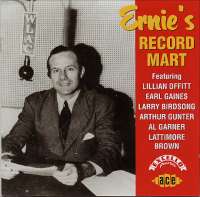
I am often asked: "Is it possible to get records or tapes of the old WLAC shows?" Possible? Well, prior to his death, John Richbourg was selling some cassette tapes that consisted largely of recreated versions of his Ernie's Record Mart shows. A small amount of material taped off the air has circulated among fans for several years but, so far as I know, there is no currently authorized material of the sort that would allow me to give a "yes" answer to this question. So what is this picture? The CD shown here is Ace CDCHD 684, Ernie's Record Mart, a reissue collection of 24 recordings originally released on Excello Records. Selections include "Miss You So" by Lillian Offitt and "Pleadin' For Love" by Larry Birdsong, but it is not a representative collection of that label's hits. The 12-page booklet is worthwhile and the disc starts off with a John R introduction similar to the one featured on this page. The last time I looked, this CD was available from Amazon.com. LINKS 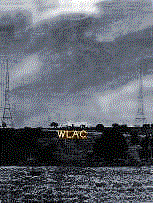
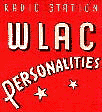
For the early history of WLAC, "the broadcast service of Life And Casualty Insurance," you can visit the station's own site. Once you arrive there, be sure to click on the red banner that looks like this. For a more extensive audio treat than those offered above, you can hear more than 5 minutes of a John R. broadcast at the exceptional "Uncle Ricky Collection" archival site. Scroll way down or search the page for WLAC to find it. Yet another worthwhile site presents an extensive treatment relating to Randy Wood and the history of the Dot records label. |
|
Just click one of these icons and bookmark or make a favorite of the page it takes you to. Thereafter, your purchases from Amazon will produce a small credit to yours truly. The eBay icon takes you to a list of items that my alter ego, Otto, is offering at auction this week. Donations Are Welcome If you are one of those rare angels who would like to make a modest donation to support my efforts, you may do so by clicking the Pay Pal "Donate" image and filling in the pertinent information that will appear on the next screen. It's fast and easy and your surprising generosity will be greatly appreciated. MORE? Many other areas of the "Popular Culture Excavation Site" await you. Full descriptions are on the main menu or go directly to the area of your choice by clicking one of these seductive little images.Return to the main menu.
This page created and maintained by Jim Lowe First appearance: September 8, 1997 Last updated: May 15, 2003 |
 If you would like to support this page and save
yourself some money in the process, please consider shopping for
your books, CDs, and videos from Amazon.com.
If you would like to support this page and save
yourself some money in the process, please consider shopping for
your books, CDs, and videos from Amazon.com.